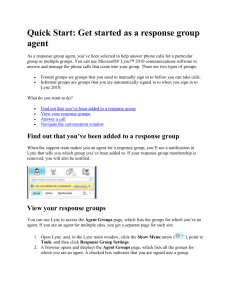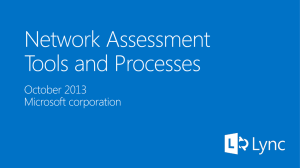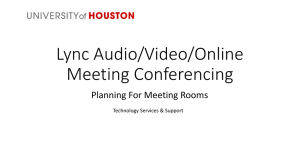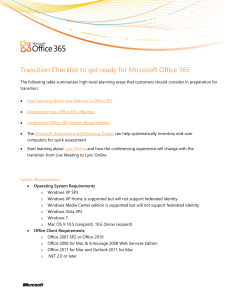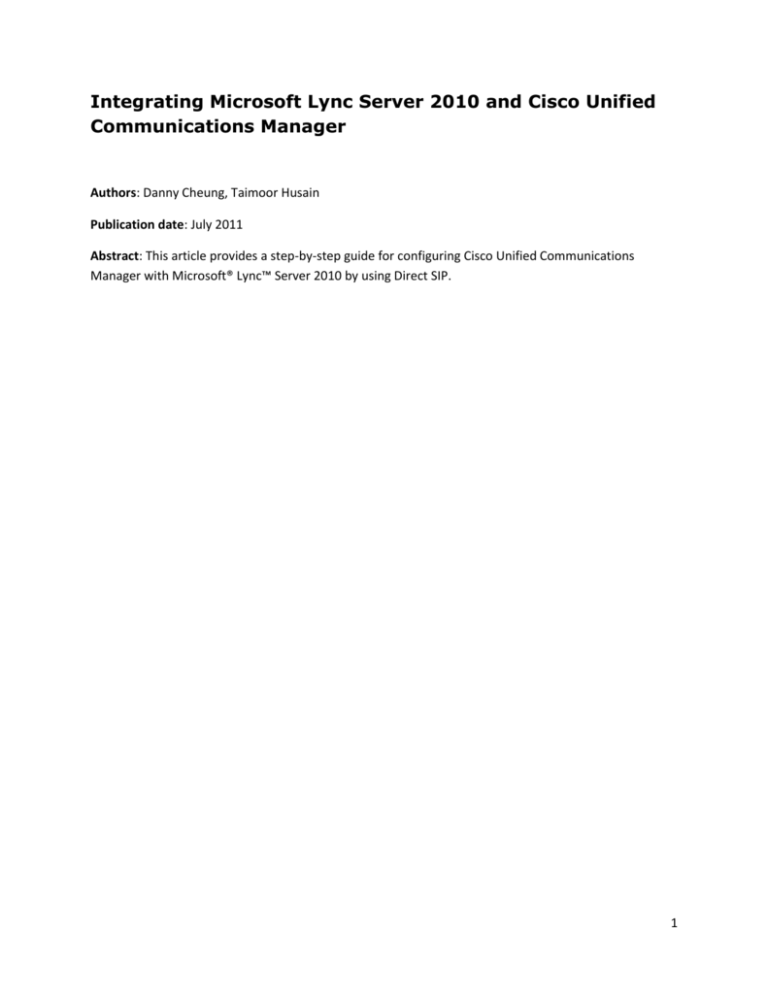
Integrating Microsoft Lync Server 2010 and Cisco Unified
Communications Manager
Authors: Danny Cheung, Taimoor Husain
Publication date: July 2011
Abstract: This article provides a step-by-step guide for configuring Cisco Unified Communications
Manager with Microsoft® Lync™ Server 2010 by using Direct SIP.
1
Integrating Microsoft Lync Server 2010 and Cisco Unified Communications Manager
This document is provided “as-is”. Information and views expressed in this document, including URL and
other Internet Web site references, may change without notice.
Some examples depicted herein are provided for illustration only and are fictitious. No real association
or connection is intended or should be inferred.
This document does not provide you with any legal rights to any intellectual property in any Microsoft
product. You may copy and use this document for your internal, reference purposes.
© 2011 Microsoft. All rights reserved.
Microsoft, Active Directory, Hyper-V, Lync, Windows, and Windows PowerShell are trademarks of the
Microsoft group of companies. All other trademarks are property of their respective owners.
2
Integrating Microsoft Lync Server 2010 and Cisco Unified Communications Manager
Contents
Integrating Microsoft Lync Server and Cisco Unified Communications Manager ........................................ 1
Configure Cisco Unified Communications Manager ..................................................................................... 2
Configure SIP Trunk................................................................................................................................... 2
Configure Translation Pattern................................................................................................................... 7
Configure Route Pattern ........................................................................................................................... 9
Configure ISR Gateway............................................................................................................................ 14
Configure Mobility (Optional) ................................................................................................................. 14
Configure Lync Server ................................................................................................................................. 17
Add CUCM to the Lync Topology ............................................................................................................ 17
Configure Dial Plan.................................................................................................................................. 18
Add Voice Policy and Route .................................................................................................................... 19
Add Trunk Configuration......................................................................................................................... 22
Configure Media Bypass ..................................................................................................................... 23
Summary ..................................................................................................................................................... 25
Additional Resources .................................................................................................................................. 26
Appendix A – Call Scenarios ........................................................................................................................ 27
3
Integrating Microsoft Lync Server and Cisco Unified Communications
Manager
Microsoft® Lync™ Server 2010 communications software can send and receive calls with Cisco Unified
Communications Manager (CUCM) by using Direct SIP. This capability has been tested by Microsoft
with multiple versions of CUCM. For details, see “Unified Communications Open Interoperability
Program—Lync Server” at http://go.microsoft.com/fwlink/?LinkId=223942.
This white paper will show step-by-step configuration tasks to set up the Direct SIP connectivity
between CUCM and Lync Server 2010. These steps include configuration of the media bypass feature
that optimizes media flow by allowing Lync endpoints to directly establish a media connection with
gateway or private branch exchange (PBX) without going through Lync Server Mediation Server.
In order to test the interoperability cases, we picked a topology that we believe most customers would
have when migrating or integrating their existing Cisco IP telephony infrastructure with Lync Server 2010
and Microsoft® Lync™ 2010.In most cases, customers would have their public switched telephone
network (PSTN) lines terminated at the Cisco ISR router and use the CUCM as a peer IP-PBX for
communicating with Lync 2010.
In our environment, the topology looks like this:
1
Figure 1. Lab topology
In our lab, the Cisco ISR is 2811 running IOS version 12.4(20)T1. Cisco Unified Communications Manager
is running on a MCS-7816-H3 hardware platform and the CUCM version is 8.5.1.11900-21.
Lync Server is running on a Hyper-V® virtualized environment and it has the Mediation Server collocated
with the Front End Server.
The hardware platform should not have any impact to the configuration and interoperability we
illustrate in this article.
We assume that you have already configured Lync and CUCM properly such that they can do call routing
at their own domain, for example, calls can be made among Cisco phones, calls can be made between
PSTN and Cisco phones, and calls can be made among Lync clients. If you don’t have these working and
need guidance, see the Lync Server TechCenter at http://go.microsoft.com/fwlink/?LinkId=201187. This
document will detail the necessary steps to connect the elements together by using Direct SIP to
exchange calls between systems.
The dial-plan looks like this:
1
The DID block for Lync and CUCM users is +120655518XX (where X represents a variable
range).
The DID block for CUCM only users is +1425555722X.
Some Lync users have a non-DID extension of 3XXX with pilot number +12065552500.
Lync and CUCM users can call each other by using a four-digit extension. For instance, 18XX,
72XX, and 3XXX.
Lync users can use the full E.164 number for internal and external calls.
CUCM users dial 9 for external calls.
We also configured remote destination on CUCM so that calls to a CUCM extension that has
a corresponding Lync user will also ring the Lync client.
Before we get into configuration, here are the host names and IP addresses for the topology in Error!
Reference source not found.:
Description
Cisco ISR
CUCM
Lync Front End
Server/Mediation Server
Host Name
VGP-CISCOGW
CUCM-COE
LyncFE.contoso.com
IP Address
10.10.125.10
10.10.125.109
10.10.125.101
Table 1. Host names and IP addresses for topology
Configure Cisco Unified Communications Manager
Here are the tasks to configure Cisco Unified Communications Manager to exchange calls with Lync by
using Direct SIP:
1.
2.
3.
4.
5.
Configure SIP Trunk.
Configure translation pattern.
Configure route pattern.
Configure SIP gateway.
Configure mobility.
Configure SIP Trunk
Note. The configuration used in our testing is a typical lab deployment, not a production
system. As a result, when we are showing screenshots, we typically show what is being changed
from the default of CUCM. Your PBX may have a different configuration that in most cases
should not affect interoperability unless called out specifically by Microsoft.
What Microsoft calls a Direct SIP connection, Cisco calls a SIP Trunk, but they refer to the same
connection type. A SIP Trunk with Cisco talks to a pool of Lync Mediation Servers.
Before creating a SIP trunk, we need to have a corresponding SIP Trunk Security Profile under System ->
Security -> SIP Profile Configuration:
2
Figure 2. CUCM SIP Trunk Security Profile
Secure real-time transport protocol (SRTP) between CUCM and Lync does not function, so the Device
Security Mode is set to Non Secure.
Select the Accept Out-of-Dialog REFER, Accept Unsolicited Notification, and Accept Replaces Header
check boxes.
Next, we need to create a SIP Profile for the SIP Trunk connecting to Lync. SIP Profile configuration is
under Device -> Device Settings -> SIP Profile :
3
Figure 3. SIP Profile Information
Under SIP Profile Information, the SDP Session-level Bandwidth Modifier for Early Offer and Re-invites
option is set by default to TIAS and AS. Change this option to TIAS only. If you leave this option at its
default setting, Lync will not understand the bandwidth modifier information in the SIP message. “TIAS”
means Transport Independent Application Specific while “AS” means Application Specific. These are SIP
options specified in RFC3890.
Figure 2. SIP Profile Configuration
One new feature in CUCM 8.5 is that it supports outgoing call setup with Early Offer without requiring
Media Termination Point (MTP). Under the SIP Profile’s Trunk Specific Configuration, select the Early
Offer Support for voice and video calls (insert MTP if needed) option. This will enable CUCM to set up
an outgoing SIP call with Early Offer.
Now we can create a SIP Trunk for Lync. First, navigate to Device -> Trunk :
4
Figure 3. New SIP Trunk
Next, configure the SIP Trunk as shown in the following:
Figure 4. SIP Trunk Device Information
Under SIP Trunk Device Information, set the Media Resource Group List to an MRGL that contains the
right media resources, particularly MTP resources that may be needed in the call.
5
The Media Termination Point Required option requires some explanation. In CUCM, MTP can be used
to provide SIP Early Offer or DTMF Relay. Lync and CUCM both support RFC 2833 for DTMF Relay, so
MTP is generally used for SIP Early Offer. Although Lync does not require Early Offer for call setup, Early
Offer is required for media bypass in Lync. Also, there are some call flows and supplementary services
that need an MTP to be inserted.
In this case, we selected Media Termination Point Required for best interoperability and call flow
support.
Note. In CUCM 8.5, together with the Early Offer Support for voice and video calls (insert MTP
if needed) option in SIP Profile configuration, you can clear the Media Termination Point
Required option. Even with Media bypass, calls can be set up without MTP inserted.
Figure 5. SIP Trunk inbound and outbound calls configuration
For inbound and outbound calls configuration in SIP Trunk, we will accept all the digits from Lync. The
Calling Search Space is one created for this Lync SIP Trunk. It contains a partition of translation patterns
that translate the called party number to CUCM extensions.
6
Figure 6. SIP Trunk - SIP Information
Under the SIP Information section of the SIP Trunk configuration, specify the Lync Mediation Server’s
address, or SRV record. In this case, we point to the Lync Front End Server, which collocates the
Mediation Server.
Here is also the place to specify the SIP Trunk security profile and SIP profile we created earlier.
Configure Translation Pattern
Lync always uses full E.164 numbers for call routing; however, most CUCM installations use short digit
extensions for enterprise call routing. So we need to configure the translation pattern to translate the
called numbers from Lync to extensions configured on the CUCM domain.
In this setup, we created two translation patterns. One to translate the enterprise E.164 numbers to
four-digit extensions in the CUCM domain. The other pattern translates any E.164 numbers to an
outbound call by using CUCM’s route pattern.
7
Figure 7. SIP Trunk Translation Pattern for internal extensions
Here, we translate the E.164 number +1425555722X coming from the Lync SIP Trunk to a four-digit
extension in CUCM. CSS has only the internal phone partition.
If a Lync user calls a four-digit extension, Lync would normalize it to the E.164 number. If the E.164
number does not match any number after reverse number lookup, Lync will send it out to the SIP Trunk
that connects to CUCM. Then CUCM will use the translation pattern to get a four-digit extension and
then route the call to a CUCM IP Phone.
8
Figure 8. SIP Trunk translation pattern for E.164 numbers
The above translation pattern is to catch the general E.164 numbers coming from the Lync SIP Trunk.
We remove the “+” sign and prefix a “9” to make it an external call for CUCM. The CSS includes
partitions for external calls. Lync just uses CUCM as a tandem switch.
Configure Route Pattern
We created three route patterns to demonstrate the Direct SIP interoperability between Lync and
CUCM:
Route patterns “18XX” and “30XX” are for CUCM users calling Lync users by using a four-digit
extension.
Route pattern “+120655518XX” is for an E.164 number set in remote destination to ring the Lync
client by using the CUCM Mobility feature.
The Route Pattern configuration can be found under Call Routing -> Route/Hunt -> Route Pattern.
9
Figure 9. Route pattern for 18XX
10
We match the pattern “18XX” and send it to the Lync SIP Trunk Trunk-Lync. This route pattern belongs
to the PT-Lync partition to differentiate it from the CUCM phone partition. We also transformed the
pattern to a full E.164 number.
11
Figure 10. Route pattern for 013X
This route pattern matches 30XX and sends it to the Lync SIP Trunk as four-digit called number. Lync will
do the normalization and then route it to the registered user.
12
Figure 11. Route pattern for Lync E.164 extension
13
This route pattern matches the E.164 number that belongs to Lync. It can be used when a CUCM user
calls a full E.164 number in the dialing range and it can be used when we specify the E.164 number in
the remote destination of the Mobility setup. The external phone number mask will send the
distinguished name’s (DN’s) full 10-digit or E.164 number as defined under the directory number as
caller ID. This is helpful in display purposes for Lync.
Configure ISR Gateway
The ISR gateway talks to CUCM in terms of call signaling. For Lync calls, media may flow directly to the
Lync Mediation Server; or in the case of media bypass, media may flow directly from the ISR to a Lync
end point. So we need to make sure that the SIP gateway can meet the requirement for media bypass.
One crucial part is that it should talk G.711 for voice codec; by default the codec is G.729.
There are two dial-peers that route to CUCM for the DIDs:
dial-peer voice 12 voip
destination-pattern 206555180.
rtp payload-type comfort-noise 13
session protocol sipv2
session target ipv4:10.10.125.109
session transport tcp
dtmf-relay rtp-nte sip-notify sip-kpml
codec g711ulaw
dial-peer voice 14 voip
destination-pattern 425555722.
rtp payload-type comfort-noise 13
session protocol sipv2
session target ipv4:10.10.125.109
session transport tcp
dtmf-relay rtp-nte sip-notify sip-kpml
codec g711ulaw
Configure Mobility (Optional)
This part of configuration is optional for Direct SIP integration between Lync and CUCM. However, it can
be a nice setup during a co-existence period where a user may have both Cisco IP Phone and Lync end
points. Any call to the CUCM extension will ring the Cisco IP Phone and Lync end point. Users can answer
the call on either device. We achieve this by using Cisco’s Mobility feature on CUCM. For details about
using the Mobility feature, see Cisco’s CUCM Administration Guide.
14
Figure 12. Remote destination profile for Garret
We configured a remote destination profile for each user (in this example, GarretV ). The profile is
associated with an end user, and it is also associated with a line number that represents the extension
that this profile will use. Next we create a remote destination that specifies the number we want to call
when this extension is being called.
Figure 13. Remote destination for Garret
In this remote destination, we entered “+12065551808” as the destination number. It is the E.164
number for Garret’s extension on the Lync side. We associate the remote destination with the remote
destination profile we created earlier. Remember to select the Line Association check box to make it
effective.
Next, configure the user information for Garret.
15
Figure 14. User information configuration for Garret
We used LDAP integration with Active Directory® Domain Services, which saves us time creating each
user and ensures that there is a single source user database for both Lync and CUCM.
On this page, the important thing to check is the Enable Mobility flag. Select the check box, and then
pick the corresponding device for the user.
CUCM is now configured. Next, we move on to configuring Lync Server.
16
Configure Lync Server
These are the tasks to configure Lync Server to perform Direct SIP integration with CUCM:
1.
2.
3.
4.
Add CUCM to the Lync topology.
Configure the dial plan.
Add voice policy and route.
Add Trunk configuration.
Add CUCM to the Lync Topology
Lync recognizes CUCM as a PSTN gateway connected by SIP. So we need to add CUCM to the Lync
topology by adding it as a PSTN gateway.
To add a PSTN gateway to the Lync topology, run Lync Server Topology Builder as a user in the
CSAdministrator group. Then add the CUCM to the PSTN gateway topology:
Figure 15. PSTN gateway configuration in Topology Builder
Gateway FQDN or IP Address is the CUCM’s IP. The Listening port should match the Incoming Port
setting in the CUCM’s SIP Trunk Security Profile. Select TCP as SIP Transport Protocol, and then assign
the PSTN gateway to the appropriate Mediation Server (for example, lyncpool01.contoso.com).
Publish the topology as showing the following to make the change effective:
17
Figure 16. Publish Topology
Configure Dial Plan
We configured three normalization rules under the global dial plan for all the enterprise voice calls. The
rules normalize 722X, 18XX, and 3XXXto their corresponding E.164 numbers:
18
Figure 17. Dial Plan configuration
After defining the normalization rules, Commit the changes to make it effective.
Add Voice Policy and Route
Each user should have a voice policy for routing the calls. In the lab, we use the global voice policy,
which by default applies to all users. The Global Voice Policy is associated with an internal PSTN usage
record.
19
Figure 18. Voice policy configuration
The PSTN usage mentioned above points to a route we created for CUCM:
Figure 19. Route list
20
Figure 20. Route configuration
The route sends calls that match any pattern to the associated gateway, which is the CUCM server we
defined.
With the combination of voice policy, PSTN usage, and route, Lync will send any non-Lync destined calls
to the CUCM.
21
Add Trunk Configuration
The final task is to configure the Trunk Configuration. Add a pool trunk, and then select the PSTN
gateway we created for the CUCM as the service. It should be configured like this:
Figure 21. Trunk Configuration
The trunk configuration defines how we want to interact with CUCM using Direct SIP. The encryption
support level is set to Optional. We don’t have any Associated Translation Rules because we are
sending the full E.164 number to CUCM.
Refer Support is turned off. Tests show that Refer does not work in the case of Lync-to-CUCM
integration. Some call transfer scenarios do not work with Refer support.
Basically, that’s all we need for Direct SIP integration with CUCM.
22
Configure Media Bypass
Media bypass is an optional feature for Direct SIP integration. However, it is a useful feature because it
removes the need for the Mediation Server in the media path, thus simplifying the deployment and
improving scalability.
In order to enable media bypass, select the Enable media bypass check box in Trunk Configuration as
shown in the following figure. Also, enable media bypass in the Network Configuration -> Global setting.
Figure 22. Network Configuration Global Setting
23
In the preceding figure, we selected Enable media bypass. If Call Admission Control is enabled, then the
option Use sites and region configuration should also be selected.
There are three parameters that need to be configured through the Windows PowerShell® command
line interface because they are not configurable on Lync Server Control Panel:
1. RTCPCallsonHold and RTCPActiveCalls must be turned off. RTCP is a control channel that
is opened and is used to monitor the network specific conditions of the RTP channel.
CUCM does not support RTCP, so if the variables are not disabled, the Mediation Server
will expect keepalives for the RTCP channel, which may cause unexpected behavior.
Set-CsTrunkConfiguration –identity <Trunk name> –RTCPActiveCalls $false –
RTCPCallsonHold $false
2. SessionTimer must be enabled. Because the RTCP channel is disabled, session timers
must be enabled so that calls don’t stay up indefinitely in case we don’t get proper
teardown of the call.
Set-CsTrunkConfiguration –identity <Trunk name> –EnableSessionTimer $true
3. Media EncryptionLevel must be set to SupportEncryption. Since we do not support SRTP
to Cisco through Direct SIP, we need to set the media configuration’s EncryptionLevel to
SupportEncryption so that SRTP will only be used if it can be negotiated. By default, this
parameter is set to RequireEncryption, meaning SRTP must be used.
Set-CsMediaConfiguration –identity Global -EncryptionLevel SupportEncryption
24
Figure 23. Windows PowerShell configuration
These will enable media bypass for this trunk.
Summary
Our testing shows that integrating Lync and CUCM by using Direct SIP works much like it did with
previous versions of CUCM. Lync introduces Media Bypass and CUCM 8.5 introduces Early Offer Support
designed to reduce the need of media resources. However, testing shows that some mid-call scenarios
25
still require the involvement of either Mediation Server or MTP to make it work. Depending on your
design and deployment, you may choose whether to use MTP resources or Mediation Server to
maximize the call flow coverage.
Additional Resources
Unified Communications Open Interoperability Program – Lync Server,
http://go.microsoft.com/fwlink/?LinkID=223942
Cisco Unified Communications Manager Documentation Guide for Release 8.5(1),
http://www.cisco.com/en/US/docs/voice_ip_comm/cucm/docguide/8_5_1/dg851.html
Microsoft® Office Communications Server 2007 R2 Enterprise Edition using Direct SIP to Cisco Unified
Communications Manager 8.0(2),
http://www.cisco.com/en/US/solutions/collateral/ns340/ns414/ns728/ns784/893165.pdf
26
Appendix A – Call Scenarios
The configuration recommended by Microsoft and detailed in this document for Direct SIP Connectivity
with a Cisco IP-PBX is to configure an MTP resource with the trunk connected to Lync Server. For a more
complete look, we also did a series of configurations with our topology where MTP is not required and
we documented the results below. Understand that because this is highly variable with regard to the
version of Cisco, PBX configuration, and the underlying network architecture, your results may vary.
The goal of integration is to get most call flows covered and use as few resources as possible (for
instance, MTP and/or Mediation Server).
In CUCM 8.5, the option Early Offer support for voice and video calls (insert MTP if needed) is
introduced. It is supposed to reduce the need of MTP in the call flow, so we tested the combination of
MTP required and Early Offer support in CUCM.
We placed calls between CUCM and Lync, and then checked the call connection, MTP usage, and media
bypass status.
Early Offer support on outbound
enabled
(This option is only available to
CUCM 8.5 or later)
MTP Require Selected
The call connects properly using
the G711 codec.
MTP is inserted on CUCM side.
Media bypass is enabled
between endpoints.
Early Offer support disabled
The call connects properly using
(This is the default behavior prior the G711 codec.
to CUCM 8.5)
MTP is inserted on CUCM side.
Media bypass is enabled
between Lync and MTP.
MTP Require Cleared
The call connects properly using
the G722 codec (direct between
endpoints).
No MTP is inserted on CUCM
side.
Media bypass is enabled.
The call connects properly using
the G711 codec.
No MTP is inserted on CUCM
side.
No media bypass.*
Table 2. Basic call flow test for Early Offer and MTP option
*Note. Call Behavior may vary between an inbound call and an outbound call.
Test shows that basic call setup works with or without the MTP Required option when Early Offer is
enabled. MTP Required simply inserts an MTP into the call flow and essentially overrides the Early
Offer feature.
When it comes to the mid-call scenario, however, there are two options to achieve the best
interoperability: either enable MTP Required on CUCM side or disable Media Bypass on Lync.
27
If Media Bypass is enabled:
Early Offer support enabled
(This option is only available to
CUCM 8.5 or later)
MTP Require Selected
1. The CUCM phone calls the
Lync client. The Lync client
transfers to another CUCM
phone. Media bypass is in
effect between Lync Client
and MTP. After the transfer,
two MTPs are in the media
path. Media bypass is
between MTP and the Lync
client.
2. The CUCM phone calls the
Lync client. Media bypass is
in effect between the Lync
client and MTP. The Lync
client transfers to another
Lync client.
After transfer, one MTP is in
the media path and the
Mediation Server is also
inserted.
3. The CUCM phone calls the
Lync client. Media bypass is
in effect between the Lync
Client and MTP. The CUCM
phone transfers to another
Lync client.
After transfer, two MTPs are
in the media path. Media
bypass is between MTP and
Lync client.
4. The CUCM phone calls the
Lync client. Media bypass is
in effect between the Lync
client and MTP. The CUCM
MTP Require Cleared
1. The CUCM phone calls the
Lync client. The Lync client
transfers to another CUCM
phone. Media bypass is in
effect between Lync Client
and MTP.
After the transfer, the
Mediation Server is inserted
(for instance, no media
bypass).
2. The CUCM phone calls the
Lync client. The Lync client
transfers to another Lync
client.
After the transfer, the
Mediation Server is inserted
(for instance, no media
bypass).
3. The CUCM phone calls the
Lync client. Media bypass is in
effect between the Lync
client and MTP. The CUCM
phone transfers to another
Lync client.
The CUCM phone can’t
complete the transfer when
trying to press the Transfer
key the second time.
4. The CUCM phone calls Lync
client. Media bypass is in
effect between the Lync
client and MTP. The CUCM
28
phone transfers to another
CUCM phone.
phone transfers to another
CUCM phone.
After the transfer, one MTP
is in the media path. Media
bypass is between MTP and
Lync client.
The CUCM phone can’t
complete the transfer when
trying to press the Transfer
key the second time.
1. The CUCM phone calls the
Lync client. Media bypass is
(This is the default behavior prior
in effect between the Lync
to CUCM 8.5)
client and MTP. The Lync
client transfers to another
CUCM phone.
Early Offer support disabled
All the scenarios become no
media bypass. No MTP is
inserted.
All call flows work with the
Mediation Server in the media
path.*
After the transfer, two MTPs
are in the media path, one
for each call setup. Media
bypass is between MTP and
Lync client.
2. The CUCM phone calls the
Lync client. Media bypass is
in effect between the Lync
client and MTP. The Lync
client transfers to another
Lync client.
After the transfer, the
Mediation Server is inserted
in the media path.
3. The CUCM phone calls the
Lync client. Media bypass is
in effect between the Lync
client and MTP. The CUCM
phone transfers to another
Lync client.
After transfer, two MTPs are
in the media path. Media
bypass is between MTP and
29
the Lync client.
4. The CUCM phone calls the
Lync client. Media bypass is
in effect between the Lync
client and MTP. The CUCM
phone transfers to another
CUCM phone.
After the transfer, one MTP
is in the media path. Media
bypass is between MTP and
the Lync client.
Table 3. Call flow scenario
*Note: Call Behavior may vary between an inbound call and an outbound call
If media bypass is disabled, all mid-call scenarios will work with the Mediation Server in the media path,
regardless of MTP on CUCM.
30

